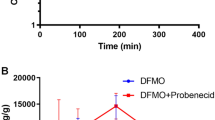Summary
In a phase I clinical trial, nine patients with advanced malignancies not amenable to alternative therapy received α-methyl-δ-acetylenic putrescine (MAP), an enzyme-activated, irreversible inhibitor of ornithine decarboxylase (ODC). MAP was given orally in increasing doses to successive groups of three patients as follows: 375 mg, 750 mg and 1500 mg/day, given as three equally divided doses for 4 weeks. Doses of 375 and 750 mg/day were well tolerated, with no detectable toxicity. Of three patients receiving 1500 mg/day, two experienced moderate to severe myelosuppression; one of these also became anuric, requiring the discontinuation of therapy after 9 days. Both effects were reversible after treatment was stopped. No objective responses were observed, with five patients having stable disease and four, progressive disease during the study period. In the seven patients in whom it could be calculated, the plasma elimination half-life t1/2 of MAP measured on the last day of treatment was between 3.9 and 9.2 h in six patients (mean, 5.6 h) and 26.1 h in the seventh. Mean steady-state trough concentrations of MAP were 2.3 μmol after the 375 mg/day dose, 7.1 μmol after 750 mg/day and 16.6 μmol after dosing with 1500 mg/day for 4 weeks, the levels after each treatment schedule being sufficient to inhibit ODC as demonstrated by increases in the urinary excretion of decarboxylated S-adenosylmethionine (dc-SAM). MAP treatment was associated with mean maximal increases in the urinary excretion of dc-SAM of 2.6-, 9.3- and 17.9-fold after 375, 750 and 1500 mg/day for 4 weeks, respectively, but no consistent changes in the urinary excretion of the polyamines, putrescine, spermidine or spermine were observed. Thus, the 24-h urinary excretion of dc-SAM may be used as a conveniently accessible marker of ODC inhibition in cancer patients.
Similar content being viewed by others
References
Abeloff MD, Slavik M, Luk GD, Griffin CA, Hermann J, Blanc O, Sjoerdsma A, Baylin SB (1984) Phase I trial and pharmacolinetic studies of α-difluoromethylornithine, an inhibitor of polyamine biosynthesis. J Clin Oncol 2: 124
Bartholeyns J, Mamont P, Casara P (1984) Antitumor properties of (2R,5R)-6-Heptyne-2,5 diamine, a new potent enzymeactivated irreversible inhibitor of ornithine decarboxylase, in rodents. Cancer Res 44: 4972
Danzin C, Casara P, Claverie N, Metcalf BW, Jung MF (1983) (2R,5R)-6-Heptyne-2,5 diamine, an extremely potent inhibitor of mammalian ornithine decarboxylase. Biochem Biophys Res Commun 116: 237
Freireich EJ, Frei E III, Karan M (1962) Methylglyoxal-bis (guanylhydrazone): a new agent active against acute myelocytic leukaemia. Cancer Chemother Rep 16: 183
Haegele KD, Splinter TAW, Romijn JC, Schechter PJ, Sjoerdsma A (1987) Decarboxylated-S-adenosylmethionine excretion: a biochemical marker of ornithine decarboxylase inhibition by α-difluoromethylornithine. Cancer Res 47: 890
Hollta E, Korpela H, Hovi T (1981) Several inhibitors of ornithine and adenosylmethionine decarboxylases may also have antiproliferative effects unrelated to polyamine depletion. Biochem Biophys Acta 677: 90
Kingsnorth A (1986) The chemotherapeutic potential of polyamine antimetabolites. Ann R Coll Surg Engl 68: 76
Maddox AM, Keating MJ, McCredie KE, Estey E, Freireich EJ (1985) Phase I evaluation of intravenous difluoromethylornithine — a polyamine inhibitor. Invest New Drugs 3: 287
Mamont PS, Danzin C, Wagner J, Siat M, Joder-Ohlenbusch A-M, Claverie N (1982) Accumulation of decarboxylated S-adenosyl-L-methionine in mammalian cells as a consequence of the inhibition of putrescine biosynthesis. Eur J Biochem 123: 499
Miller AB, Hoogstraten B, Staquet M, Winkler A (1981) Reporting results of cancer treatment. Cancer 47: 207
Pegg AE, McCann P (1982) Polyamine metabolism and function. Am J Physiol 243c: 212
Pera PJ, Kramer DL, Sufrin JR, Porter CW (1986) Comparison of the biological effects of four irreversible inhibitors of ornithine decarboxylase in two murine lymphocytic leukemia cell lines. Cancer Res 46: 1148
Schechter PJ, Sjoerdsma A (1986) Difluoromethylornithine in the treatment of African trypanosomiasis. Parasitol Today 2: 223
Seiler N, Knödgen B (1980) High-performance liquid chromatographic procedure for the simultaneous determination of the natural polyamines and their monoacetyl derivatives. J Chromatogr 221: 227
Sjoerdsma A, Schechter PJ (1984) Chemotherapeutic implications of polyamine biosynthesis inhibition. Clin Pharmacol Ther 35: 287
Spencer RD, Weben G, Tolman GL, Barrio JR, Leonard MJ (1974) Species responsible for the fluorescence of 1:N6-ethenoadenosine. Eur J Biochem 45: 425
Wagner J, Hirth Y, Claverie N, Danzin C (1986) A sensitive high-performance liquid chromatographic procedure with fluorometric detection for the analysis of decarboxylated S-adenosylmethionine and analogs in urine samples. Anal Biochem 154: 604
Warrell RP, Burchenal JH (1983) Methylglyoxal-bis(guanylhydrazone) (MGBG). Current status and future prospects. J Clin Oncol 1: 52
Williams-Ashman HG, Scherone A (1972) MGBG as a potent inhibitor of mammalian and yeast S-adenosylmethionine decarboxylases. Biochem Biophys Res Commun 46: 288
Author information
Authors and Affiliations
Rights and permissions
About this article
Cite this article
Cornbleet, M.A., Kingsnorth, A., Tell, G.P. et al. Phase I study of methylacetylenic putrescine, an inhibitor of polyamine biosynthesis. Cancer Chemother. Pharmacol. 23, 348–352 (1989). https://doi.org/10.1007/BF00435834
Received:
Accepted:
Issue Date:
DOI: https://doi.org/10.1007/BF00435834




